Research Project: Pandemic's Impact on Workplace Transformation
VerifiedAdded on 2023/06/14
|30
|6800
|175
Report
AI Summary
This report investigates the impact of the COVID-19 pandemic on workplace transformation strategies within the DCS Group. It explores the challenges faced by the organization due to government restrictions and the accelerated need for digital adoption. The research employs both primary and secondary data collection methods to address the research aim: to analyze the pandemic's influence on workplace transformation. Key objectives include understanding workplace transformation concepts, identifying challenges faced by DCS Group during this period, and evaluating effective implementation strategies. The report delves into the existing literature, research methodology, findings, and analysis, concluding with recommendations for effectively navigating workplace transformation in the face of ongoing and future disruptions. It highlights the importance of agile processes, cultural adaptation, strategic transformations, and digital integration for organizational success during and after the pandemic. Desklib provides access to similar solved assignments and resources for students.

Unit 11 Research Project
(Impact of global pandemic in acceleration of workplace
transformation within organization)
(Impact of global pandemic in acceleration of workplace
transformation within organization)
Paraphrase This Document
Need a fresh take? Get an instant paraphrase of this document with our AI Paraphraser

EXECUTIVE SUMMARY
The main purpose of current investigation is fulfilled by collecting in-depth information
about the impact of COVID-19 on workplace transformation strategies of an organisation. This
report has also covered the challenges faced by an organisation due to sudden restrictions
imposed by the Government to control spread of COVID-19. This report has shown dependence
over primary and secondary methods for collecting apt information related to the selected
research topic.
The main purpose of current investigation is fulfilled by collecting in-depth information
about the impact of COVID-19 on workplace transformation strategies of an organisation. This
report has also covered the challenges faced by an organisation due to sudden restrictions
imposed by the Government to control spread of COVID-19. This report has shown dependence
over primary and secondary methods for collecting apt information related to the selected
research topic.
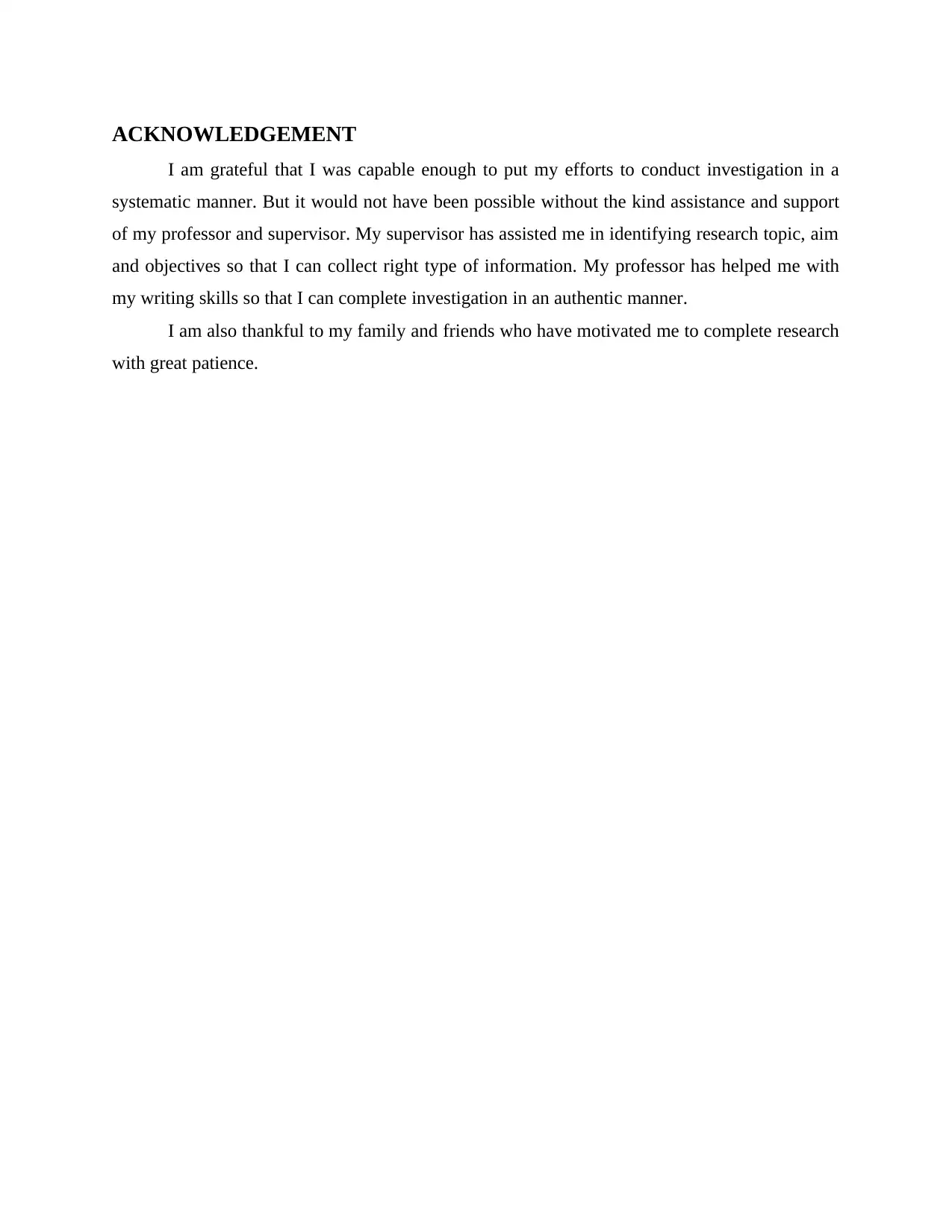
ACKNOWLEDGEMENT
I am grateful that I was capable enough to put my efforts to conduct investigation in a
systematic manner. But it would not have been possible without the kind assistance and support
of my professor and supervisor. My supervisor has assisted me in identifying research topic, aim
and objectives so that I can collect right type of information. My professor has helped me with
my writing skills so that I can complete investigation in an authentic manner.
I am also thankful to my family and friends who have motivated me to complete research
with great patience.
I am grateful that I was capable enough to put my efforts to conduct investigation in a
systematic manner. But it would not have been possible without the kind assistance and support
of my professor and supervisor. My supervisor has assisted me in identifying research topic, aim
and objectives so that I can collect right type of information. My professor has helped me with
my writing skills so that I can complete investigation in an authentic manner.
I am also thankful to my family and friends who have motivated me to complete research
with great patience.
⊘ This is a preview!⊘
Do you want full access?
Subscribe today to unlock all pages.

Trusted by 1+ million students worldwide
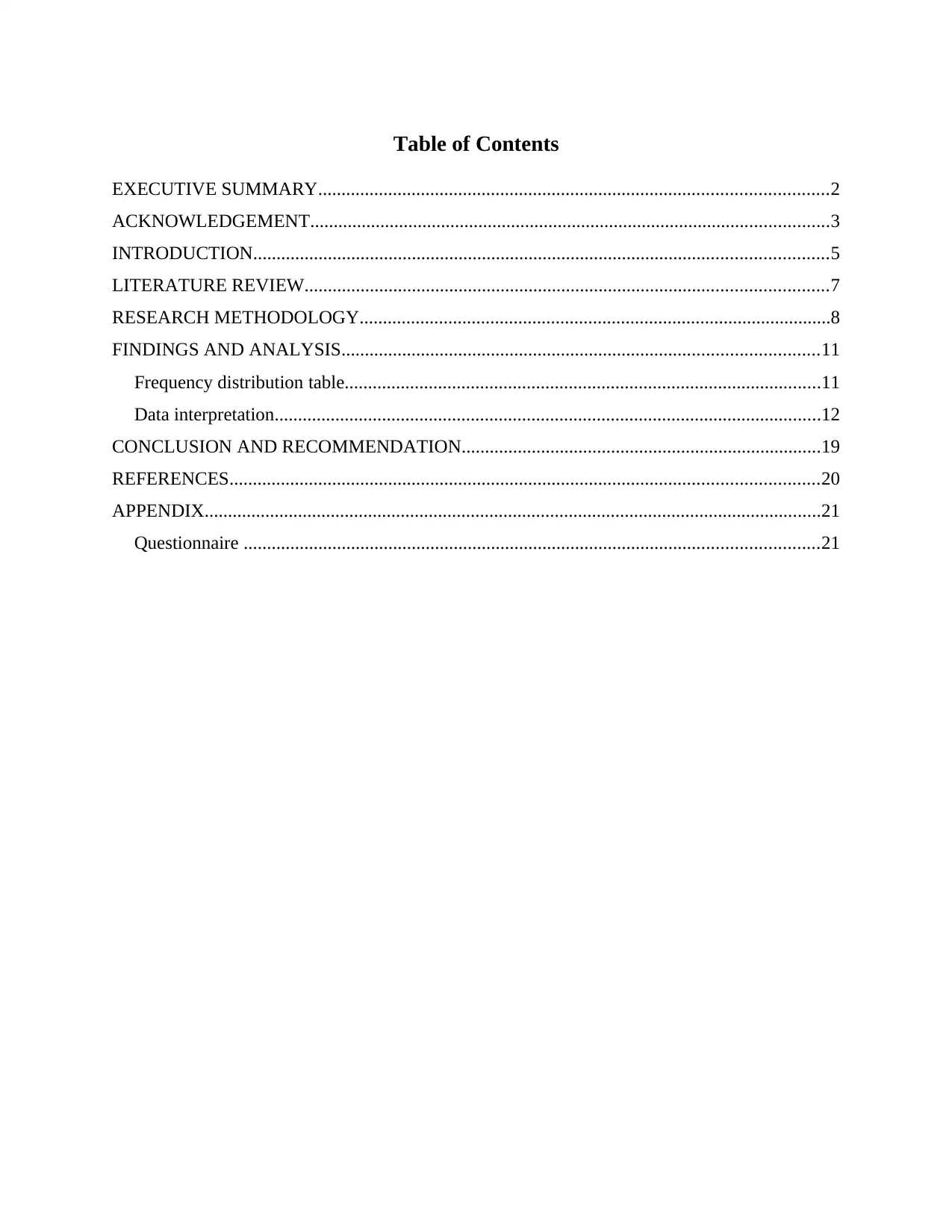
Table of Contents
EXECUTIVE SUMMARY.............................................................................................................2
ACKNOWLEDGEMENT...............................................................................................................3
INTRODUCTION...........................................................................................................................5
LITERATURE REVIEW................................................................................................................7
RESEARCH METHODOLOGY.....................................................................................................8
FINDINGS AND ANALYSIS......................................................................................................11
Frequency distribution table......................................................................................................11
Data interpretation.....................................................................................................................12
CONCLUSION AND RECOMMENDATION.............................................................................19
REFERENCES..............................................................................................................................20
APPENDIX....................................................................................................................................21
Questionnaire ...........................................................................................................................21
EXECUTIVE SUMMARY.............................................................................................................2
ACKNOWLEDGEMENT...............................................................................................................3
INTRODUCTION...........................................................................................................................5
LITERATURE REVIEW................................................................................................................7
RESEARCH METHODOLOGY.....................................................................................................8
FINDINGS AND ANALYSIS......................................................................................................11
Frequency distribution table......................................................................................................11
Data interpretation.....................................................................................................................12
CONCLUSION AND RECOMMENDATION.............................................................................19
REFERENCES..............................................................................................................................20
APPENDIX....................................................................................................................................21
Questionnaire ...........................................................................................................................21
Paraphrase This Document
Need a fresh take? Get an instant paraphrase of this document with our AI Paraphraser
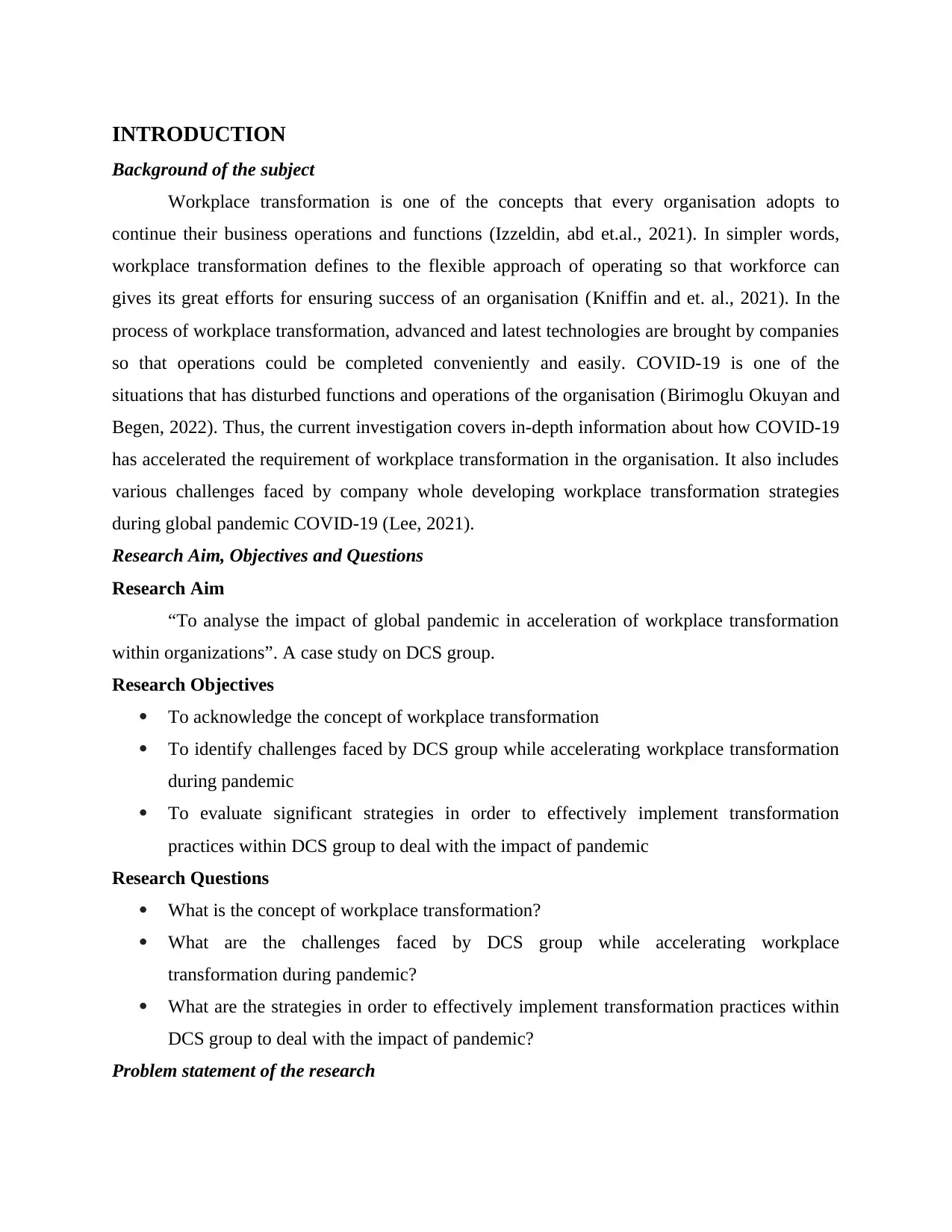
INTRODUCTION
Background of the subject
Workplace transformation is one of the concepts that every organisation adopts to
continue their business operations and functions (Izzeldin, abd et.al., 2021). In simpler words,
workplace transformation defines to the flexible approach of operating so that workforce can
gives its great efforts for ensuring success of an organisation (Kniffin and et. al., 2021). In the
process of workplace transformation, advanced and latest technologies are brought by companies
so that operations could be completed conveniently and easily. COVID-19 is one of the
situations that has disturbed functions and operations of the organisation (Birimoglu Okuyan and
Begen, 2022). Thus, the current investigation covers in-depth information about how COVID-19
has accelerated the requirement of workplace transformation in the organisation. It also includes
various challenges faced by company whole developing workplace transformation strategies
during global pandemic COVID-19 (Lee, 2021).
Research Aim, Objectives and Questions
Research Aim
“To analyse the impact of global pandemic in acceleration of workplace transformation
within organizations”. A case study on DCS group.
Research Objectives
To acknowledge the concept of workplace transformation
To identify challenges faced by DCS group while accelerating workplace transformation
during pandemic
To evaluate significant strategies in order to effectively implement transformation
practices within DCS group to deal with the impact of pandemic
Research Questions
What is the concept of workplace transformation?
What are the challenges faced by DCS group while accelerating workplace
transformation during pandemic?
What are the strategies in order to effectively implement transformation practices within
DCS group to deal with the impact of pandemic?
Problem statement of the research
Background of the subject
Workplace transformation is one of the concepts that every organisation adopts to
continue their business operations and functions (Izzeldin, abd et.al., 2021). In simpler words,
workplace transformation defines to the flexible approach of operating so that workforce can
gives its great efforts for ensuring success of an organisation (Kniffin and et. al., 2021). In the
process of workplace transformation, advanced and latest technologies are brought by companies
so that operations could be completed conveniently and easily. COVID-19 is one of the
situations that has disturbed functions and operations of the organisation (Birimoglu Okuyan and
Begen, 2022). Thus, the current investigation covers in-depth information about how COVID-19
has accelerated the requirement of workplace transformation in the organisation. It also includes
various challenges faced by company whole developing workplace transformation strategies
during global pandemic COVID-19 (Lee, 2021).
Research Aim, Objectives and Questions
Research Aim
“To analyse the impact of global pandemic in acceleration of workplace transformation
within organizations”. A case study on DCS group.
Research Objectives
To acknowledge the concept of workplace transformation
To identify challenges faced by DCS group while accelerating workplace transformation
during pandemic
To evaluate significant strategies in order to effectively implement transformation
practices within DCS group to deal with the impact of pandemic
Research Questions
What is the concept of workplace transformation?
What are the challenges faced by DCS group while accelerating workplace
transformation during pandemic?
What are the strategies in order to effectively implement transformation practices within
DCS group to deal with the impact of pandemic?
Problem statement of the research
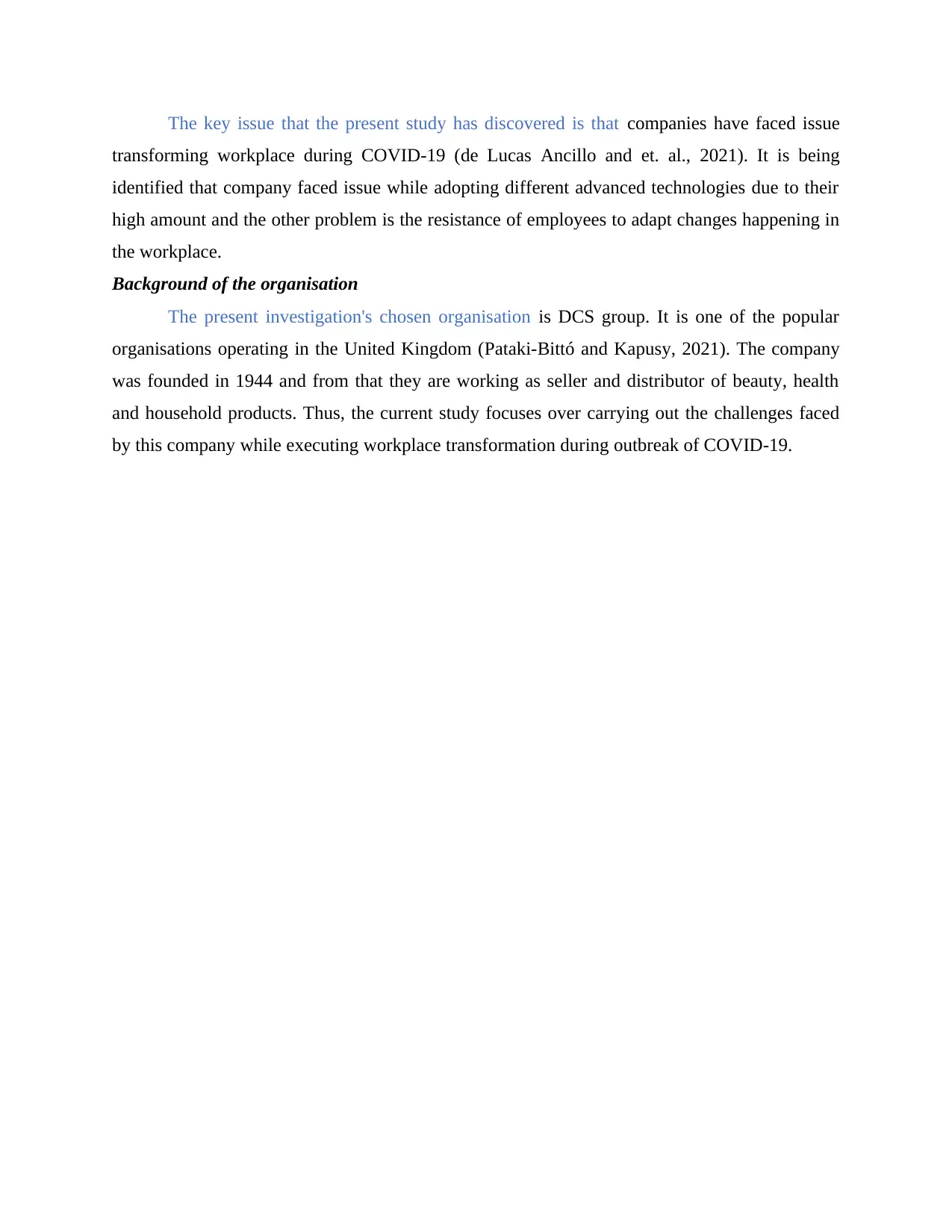
The key issue that the present study has discovered is that companies have faced issue
transforming workplace during COVID-19 (de Lucas Ancillo and et. al., 2021). It is being
identified that company faced issue while adopting different advanced technologies due to their
high amount and the other problem is the resistance of employees to adapt changes happening in
the workplace.
Background of the organisation
The present investigation's chosen organisation is DCS group. It is one of the popular
organisations operating in the United Kingdom (Pataki-Bittó and Kapusy, 2021). The company
was founded in 1944 and from that they are working as seller and distributor of beauty, health
and household products. Thus, the current study focuses over carrying out the challenges faced
by this company while executing workplace transformation during outbreak of COVID-19.
transforming workplace during COVID-19 (de Lucas Ancillo and et. al., 2021). It is being
identified that company faced issue while adopting different advanced technologies due to their
high amount and the other problem is the resistance of employees to adapt changes happening in
the workplace.
Background of the organisation
The present investigation's chosen organisation is DCS group. It is one of the popular
organisations operating in the United Kingdom (Pataki-Bittó and Kapusy, 2021). The company
was founded in 1944 and from that they are working as seller and distributor of beauty, health
and household products. Thus, the current study focuses over carrying out the challenges faced
by this company while executing workplace transformation during outbreak of COVID-19.
⊘ This is a preview!⊘
Do you want full access?
Subscribe today to unlock all pages.

Trusted by 1+ million students worldwide
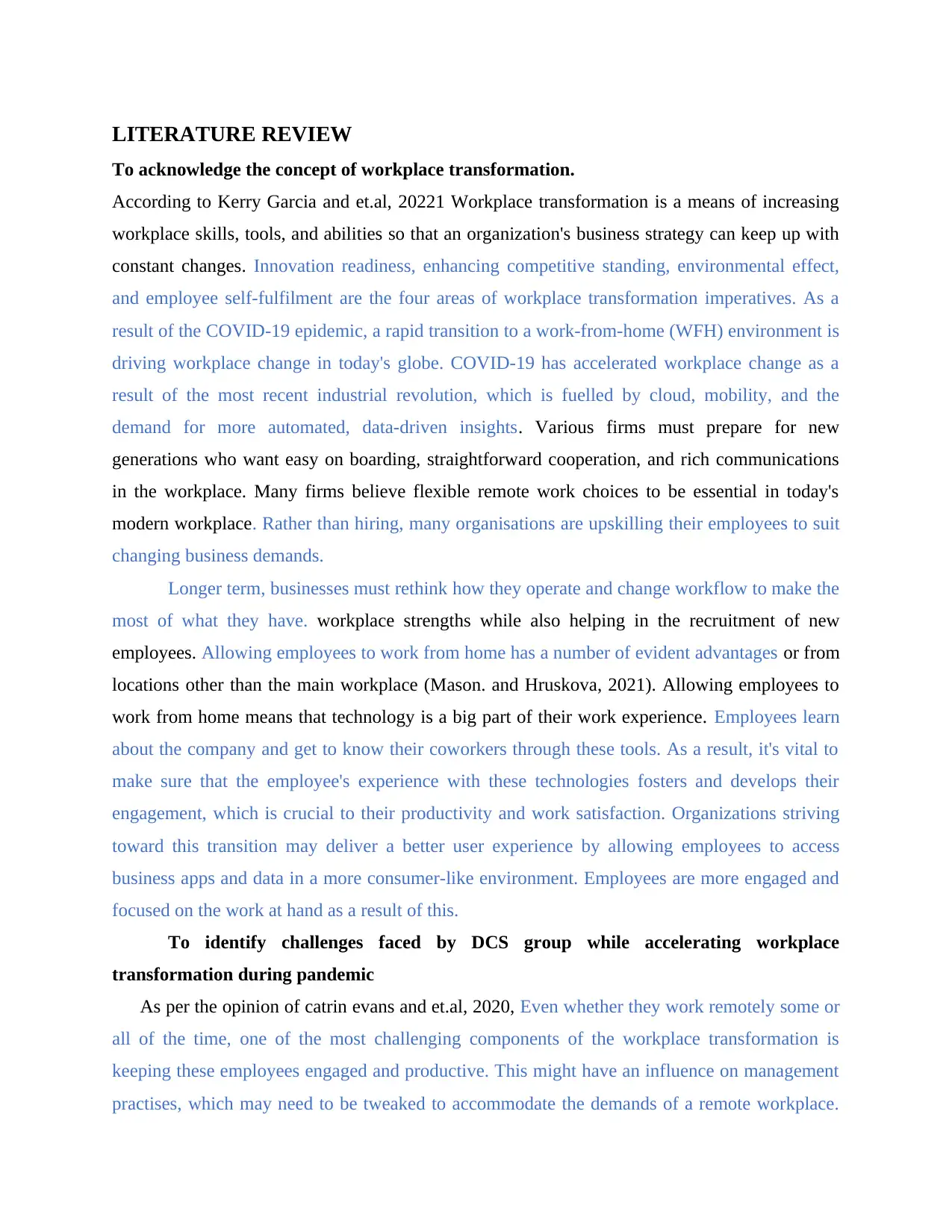
LITERATURE REVIEW
To acknowledge the concept of workplace transformation.
According to Kerry Garcia and et.al, 20221 Workplace transformation is a means of increasing
workplace skills, tools, and abilities so that an organization's business strategy can keep up with
constant changes. Innovation readiness, enhancing competitive standing, environmental effect,
and employee self-fulfilment are the four areas of workplace transformation imperatives. As a
result of the COVID-19 epidemic, a rapid transition to a work-from-home (WFH) environment is
driving workplace change in today's globe. COVID-19 has accelerated workplace change as a
result of the most recent industrial revolution, which is fuelled by cloud, mobility, and the
demand for more automated, data-driven insights. Various firms must prepare for new
generations who want easy on boarding, straightforward cooperation, and rich communications
in the workplace. Many firms believe flexible remote work choices to be essential in today's
modern workplace. Rather than hiring, many organisations are upskilling their employees to suit
changing business demands.
Longer term, businesses must rethink how they operate and change workflow to make the
most of what they have. workplace strengths while also helping in the recruitment of new
employees. Allowing employees to work from home has a number of evident advantages or from
locations other than the main workplace (Mason. and Hruskova, 2021). Allowing employees to
work from home means that technology is a big part of their work experience. Employees learn
about the company and get to know their coworkers through these tools. As a result, it's vital to
make sure that the employee's experience with these technologies fosters and develops their
engagement, which is crucial to their productivity and work satisfaction. Organizations striving
toward this transition may deliver a better user experience by allowing employees to access
business apps and data in a more consumer-like environment. Employees are more engaged and
focused on the work at hand as a result of this.
To identify challenges faced by DCS group while accelerating workplace
transformation during pandemic
As per the opinion of catrin evans and et.al, 2020, Even whether they work remotely some or
all of the time, one of the most challenging components of the workplace transformation is
keeping these employees engaged and productive. This might have an influence on management
practises, which may need to be tweaked to accommodate the demands of a remote workplace.
To acknowledge the concept of workplace transformation.
According to Kerry Garcia and et.al, 20221 Workplace transformation is a means of increasing
workplace skills, tools, and abilities so that an organization's business strategy can keep up with
constant changes. Innovation readiness, enhancing competitive standing, environmental effect,
and employee self-fulfilment are the four areas of workplace transformation imperatives. As a
result of the COVID-19 epidemic, a rapid transition to a work-from-home (WFH) environment is
driving workplace change in today's globe. COVID-19 has accelerated workplace change as a
result of the most recent industrial revolution, which is fuelled by cloud, mobility, and the
demand for more automated, data-driven insights. Various firms must prepare for new
generations who want easy on boarding, straightforward cooperation, and rich communications
in the workplace. Many firms believe flexible remote work choices to be essential in today's
modern workplace. Rather than hiring, many organisations are upskilling their employees to suit
changing business demands.
Longer term, businesses must rethink how they operate and change workflow to make the
most of what they have. workplace strengths while also helping in the recruitment of new
employees. Allowing employees to work from home has a number of evident advantages or from
locations other than the main workplace (Mason. and Hruskova, 2021). Allowing employees to
work from home means that technology is a big part of their work experience. Employees learn
about the company and get to know their coworkers through these tools. As a result, it's vital to
make sure that the employee's experience with these technologies fosters and develops their
engagement, which is crucial to their productivity and work satisfaction. Organizations striving
toward this transition may deliver a better user experience by allowing employees to access
business apps and data in a more consumer-like environment. Employees are more engaged and
focused on the work at hand as a result of this.
To identify challenges faced by DCS group while accelerating workplace
transformation during pandemic
As per the opinion of catrin evans and et.al, 2020, Even whether they work remotely some or
all of the time, one of the most challenging components of the workplace transformation is
keeping these employees engaged and productive. This might have an influence on management
practises, which may need to be tweaked to accommodate the demands of a remote workplace.
Paraphrase This Document
Need a fresh take? Get an instant paraphrase of this document with our AI Paraphraser
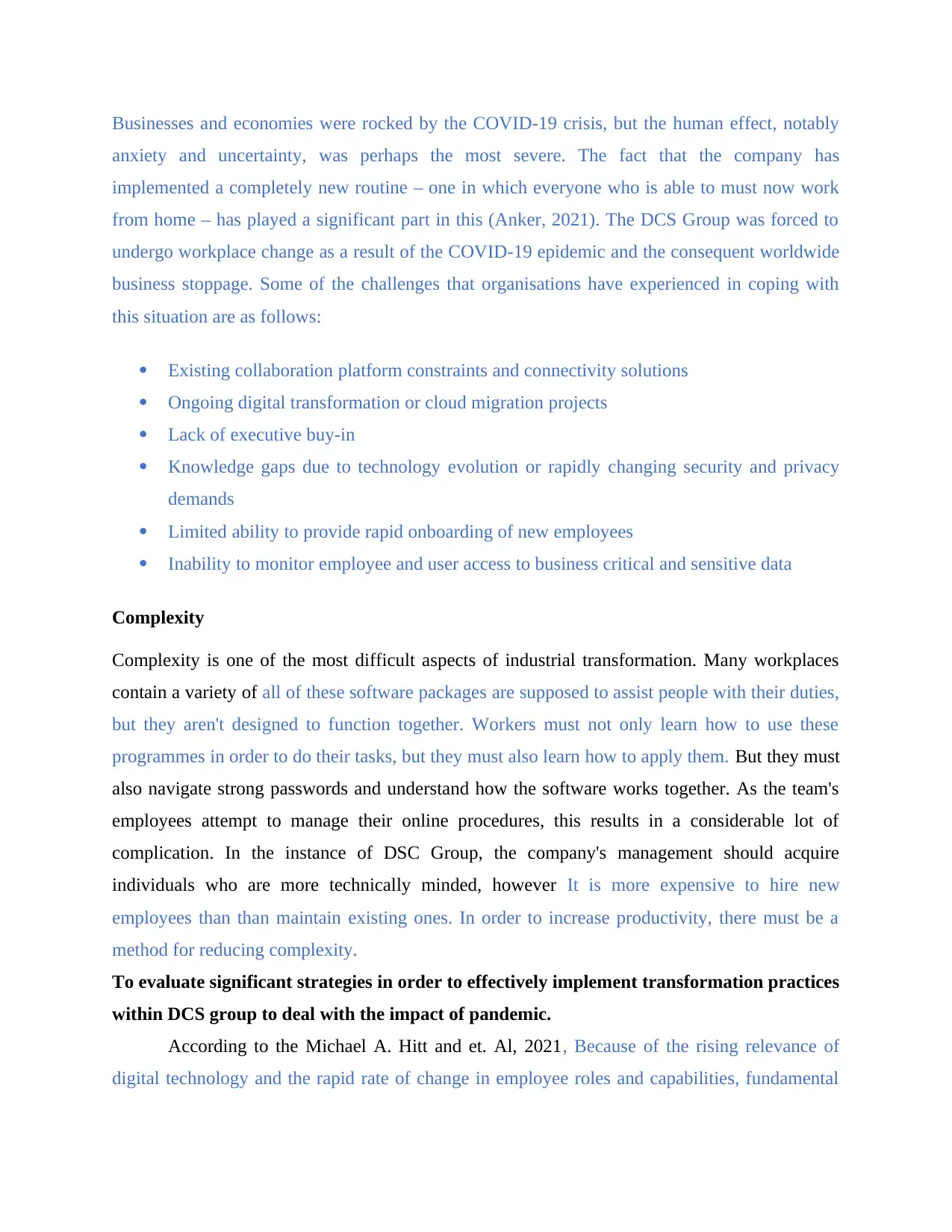
Businesses and economies were rocked by the COVID-19 crisis, but the human effect, notably
anxiety and uncertainty, was perhaps the most severe. The fact that the company has
implemented a completely new routine – one in which everyone who is able to must now work
from home – has played a significant part in this (Anker, 2021). The DCS Group was forced to
undergo workplace change as a result of the COVID-19 epidemic and the consequent worldwide
business stoppage. Some of the challenges that organisations have experienced in coping with
this situation are as follows:
Existing collaboration platform constraints and connectivity solutions
Ongoing digital transformation or cloud migration projects
Lack of executive buy-in
Knowledge gaps due to technology evolution or rapidly changing security and privacy
demands
Limited ability to provide rapid onboarding of new employees
Inability to monitor employee and user access to business critical and sensitive data
Complexity
Complexity is one of the most difficult aspects of industrial transformation. Many workplaces
contain a variety of all of these software packages are supposed to assist people with their duties,
but they aren't designed to function together. Workers must not only learn how to use these
programmes in order to do their tasks, but they must also learn how to apply them. But they must
also navigate strong passwords and understand how the software works together. As the team's
employees attempt to manage their online procedures, this results in a considerable lot of
complication. In the instance of DSC Group, the company's management should acquire
individuals who are more technically minded, however It is more expensive to hire new
employees than than maintain existing ones. In order to increase productivity, there must be a
method for reducing complexity.
To evaluate significant strategies in order to effectively implement transformation practices
within DCS group to deal with the impact of pandemic.
According to the Michael A. Hitt and et. Al, 2021, Because of the rising relevance of
digital technology and the rapid rate of change in employee roles and capabilities, fundamental
anxiety and uncertainty, was perhaps the most severe. The fact that the company has
implemented a completely new routine – one in which everyone who is able to must now work
from home – has played a significant part in this (Anker, 2021). The DCS Group was forced to
undergo workplace change as a result of the COVID-19 epidemic and the consequent worldwide
business stoppage. Some of the challenges that organisations have experienced in coping with
this situation are as follows:
Existing collaboration platform constraints and connectivity solutions
Ongoing digital transformation or cloud migration projects
Lack of executive buy-in
Knowledge gaps due to technology evolution or rapidly changing security and privacy
demands
Limited ability to provide rapid onboarding of new employees
Inability to monitor employee and user access to business critical and sensitive data
Complexity
Complexity is one of the most difficult aspects of industrial transformation. Many workplaces
contain a variety of all of these software packages are supposed to assist people with their duties,
but they aren't designed to function together. Workers must not only learn how to use these
programmes in order to do their tasks, but they must also learn how to apply them. But they must
also navigate strong passwords and understand how the software works together. As the team's
employees attempt to manage their online procedures, this results in a considerable lot of
complication. In the instance of DSC Group, the company's management should acquire
individuals who are more technically minded, however It is more expensive to hire new
employees than than maintain existing ones. In order to increase productivity, there must be a
method for reducing complexity.
To evaluate significant strategies in order to effectively implement transformation practices
within DCS group to deal with the impact of pandemic.
According to the Michael A. Hitt and et. Al, 2021, Because of the rising relevance of
digital technology and the rapid rate of change in employee roles and capabilities, fundamental
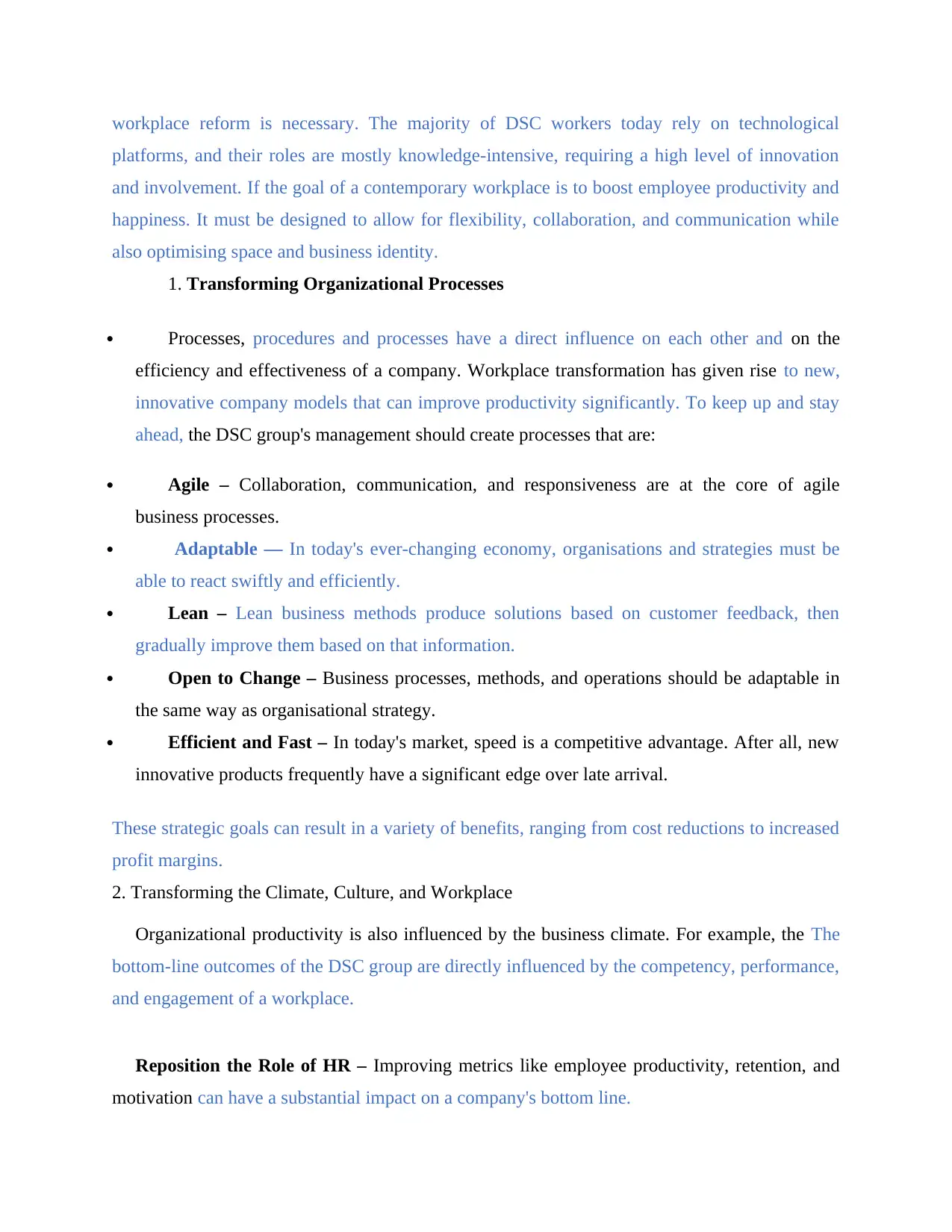
workplace reform is necessary. The majority of DSC workers today rely on technological
platforms, and their roles are mostly knowledge-intensive, requiring a high level of innovation
and involvement. If the goal of a contemporary workplace is to boost employee productivity and
happiness. It must be designed to allow for flexibility, collaboration, and communication while
also optimising space and business identity.
1. Transforming Organizational Processes
Processes, procedures and processes have a direct influence on each other and on the
efficiency and effectiveness of a company. Workplace transformation has given rise to new,
innovative company models that can improve productivity significantly. To keep up and stay
ahead, the DSC group's management should create processes that are:
Agile – Collaboration, communication, and responsiveness are at the core of agile
business processes.
Adaptable — In today's ever-changing economy, organisations and strategies must be
able to react swiftly and efficiently.
Lean – Lean business methods produce solutions based on customer feedback, then
gradually improve them based on that information.
Open to Change – Business processes, methods, and operations should be adaptable in
the same way as organisational strategy.
Efficient and Fast – In today's market, speed is a competitive advantage. After all, new
innovative products frequently have a significant edge over late arrival.
These strategic goals can result in a variety of benefits, ranging from cost reductions to increased
profit margins.
2. Transforming the Climate, Culture, and Workplace
Organizational productivity is also influenced by the business climate. For example, the The
bottom-line outcomes of the DSC group are directly influenced by the competency, performance,
and engagement of a workplace.
Reposition the Role of HR – Improving metrics like employee productivity, retention, and
motivation can have a substantial impact on a company's bottom line.
platforms, and their roles are mostly knowledge-intensive, requiring a high level of innovation
and involvement. If the goal of a contemporary workplace is to boost employee productivity and
happiness. It must be designed to allow for flexibility, collaboration, and communication while
also optimising space and business identity.
1. Transforming Organizational Processes
Processes, procedures and processes have a direct influence on each other and on the
efficiency and effectiveness of a company. Workplace transformation has given rise to new,
innovative company models that can improve productivity significantly. To keep up and stay
ahead, the DSC group's management should create processes that are:
Agile – Collaboration, communication, and responsiveness are at the core of agile
business processes.
Adaptable — In today's ever-changing economy, organisations and strategies must be
able to react swiftly and efficiently.
Lean – Lean business methods produce solutions based on customer feedback, then
gradually improve them based on that information.
Open to Change – Business processes, methods, and operations should be adaptable in
the same way as organisational strategy.
Efficient and Fast – In today's market, speed is a competitive advantage. After all, new
innovative products frequently have a significant edge over late arrival.
These strategic goals can result in a variety of benefits, ranging from cost reductions to increased
profit margins.
2. Transforming the Climate, Culture, and Workplace
Organizational productivity is also influenced by the business climate. For example, the The
bottom-line outcomes of the DSC group are directly influenced by the competency, performance,
and engagement of a workplace.
Reposition the Role of HR – Improving metrics like employee productivity, retention, and
motivation can have a substantial impact on a company's bottom line.
⊘ This is a preview!⊘
Do you want full access?
Subscribe today to unlock all pages.

Trusted by 1+ million students worldwide
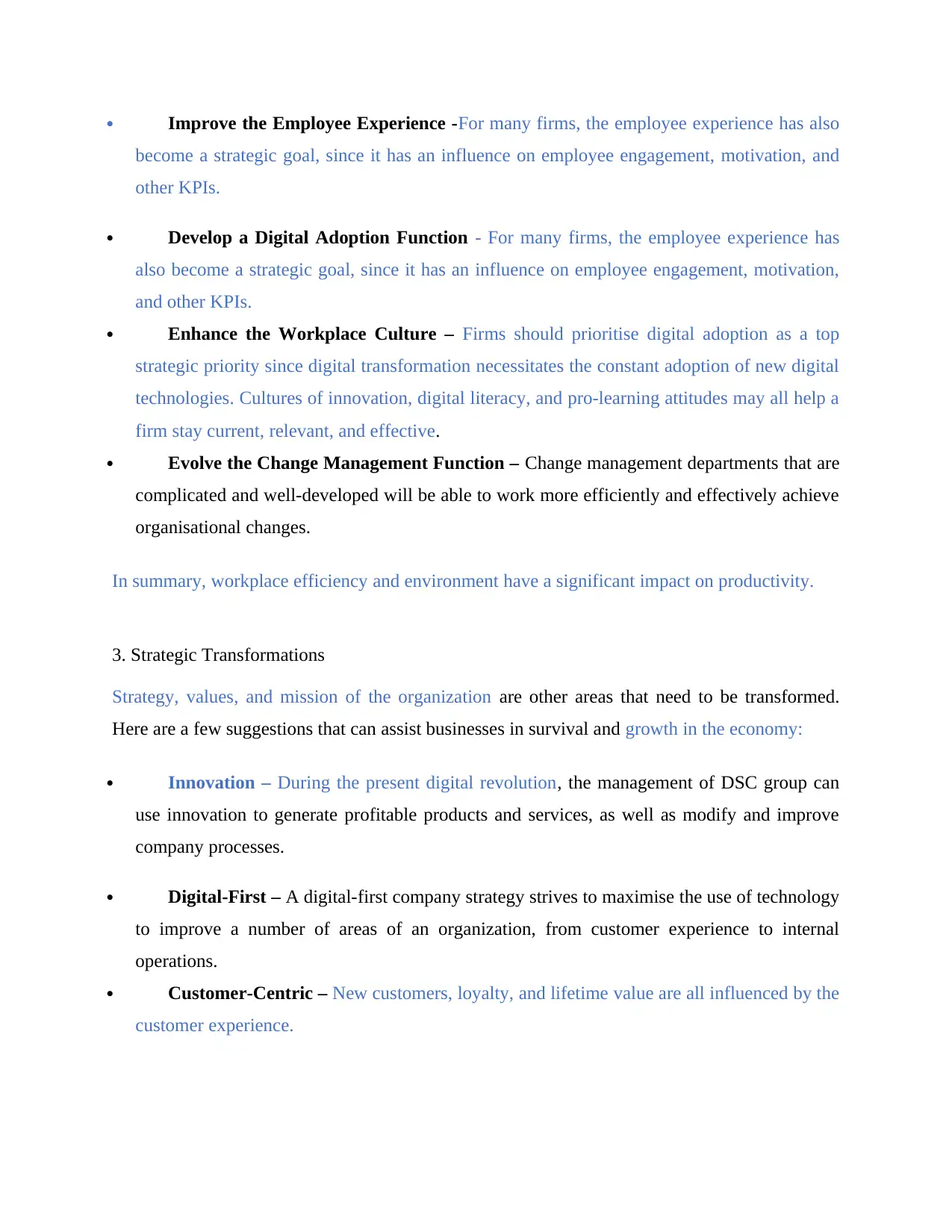
Improve the Employee Experience -For many firms, the employee experience has also
become a strategic goal, since it has an influence on employee engagement, motivation, and
other KPIs.
Develop a Digital Adoption Function - For many firms, the employee experience has
also become a strategic goal, since it has an influence on employee engagement, motivation,
and other KPIs.
Enhance the Workplace Culture – Firms should prioritise digital adoption as a top
strategic priority since digital transformation necessitates the constant adoption of new digital
technologies. Cultures of innovation, digital literacy, and pro-learning attitudes may all help a
firm stay current, relevant, and effective.
Evolve the Change Management Function – Change management departments that are
complicated and well-developed will be able to work more efficiently and effectively achieve
organisational changes.
In summary, workplace efficiency and environment have a significant impact on productivity.
3. Strategic Transformations
Strategy, values, and mission of the organization are other areas that need to be transformed.
Here are a few suggestions that can assist businesses in survival and growth in the economy:
Innovation – During the present digital revolution, the management of DSC group can
use innovation to generate profitable products and services, as well as modify and improve
company processes.
Digital-First – A digital-first company strategy strives to maximise the use of technology
to improve a number of areas of an organization, from customer experience to internal
operations.
Customer-Centric – New customers, loyalty, and lifetime value are all influenced by the
customer experience.
become a strategic goal, since it has an influence on employee engagement, motivation, and
other KPIs.
Develop a Digital Adoption Function - For many firms, the employee experience has
also become a strategic goal, since it has an influence on employee engagement, motivation,
and other KPIs.
Enhance the Workplace Culture – Firms should prioritise digital adoption as a top
strategic priority since digital transformation necessitates the constant adoption of new digital
technologies. Cultures of innovation, digital literacy, and pro-learning attitudes may all help a
firm stay current, relevant, and effective.
Evolve the Change Management Function – Change management departments that are
complicated and well-developed will be able to work more efficiently and effectively achieve
organisational changes.
In summary, workplace efficiency and environment have a significant impact on productivity.
3. Strategic Transformations
Strategy, values, and mission of the organization are other areas that need to be transformed.
Here are a few suggestions that can assist businesses in survival and growth in the economy:
Innovation – During the present digital revolution, the management of DSC group can
use innovation to generate profitable products and services, as well as modify and improve
company processes.
Digital-First – A digital-first company strategy strives to maximise the use of technology
to improve a number of areas of an organization, from customer experience to internal
operations.
Customer-Centric – New customers, loyalty, and lifetime value are all influenced by the
customer experience.
Paraphrase This Document
Need a fresh take? Get an instant paraphrase of this document with our AI Paraphraser
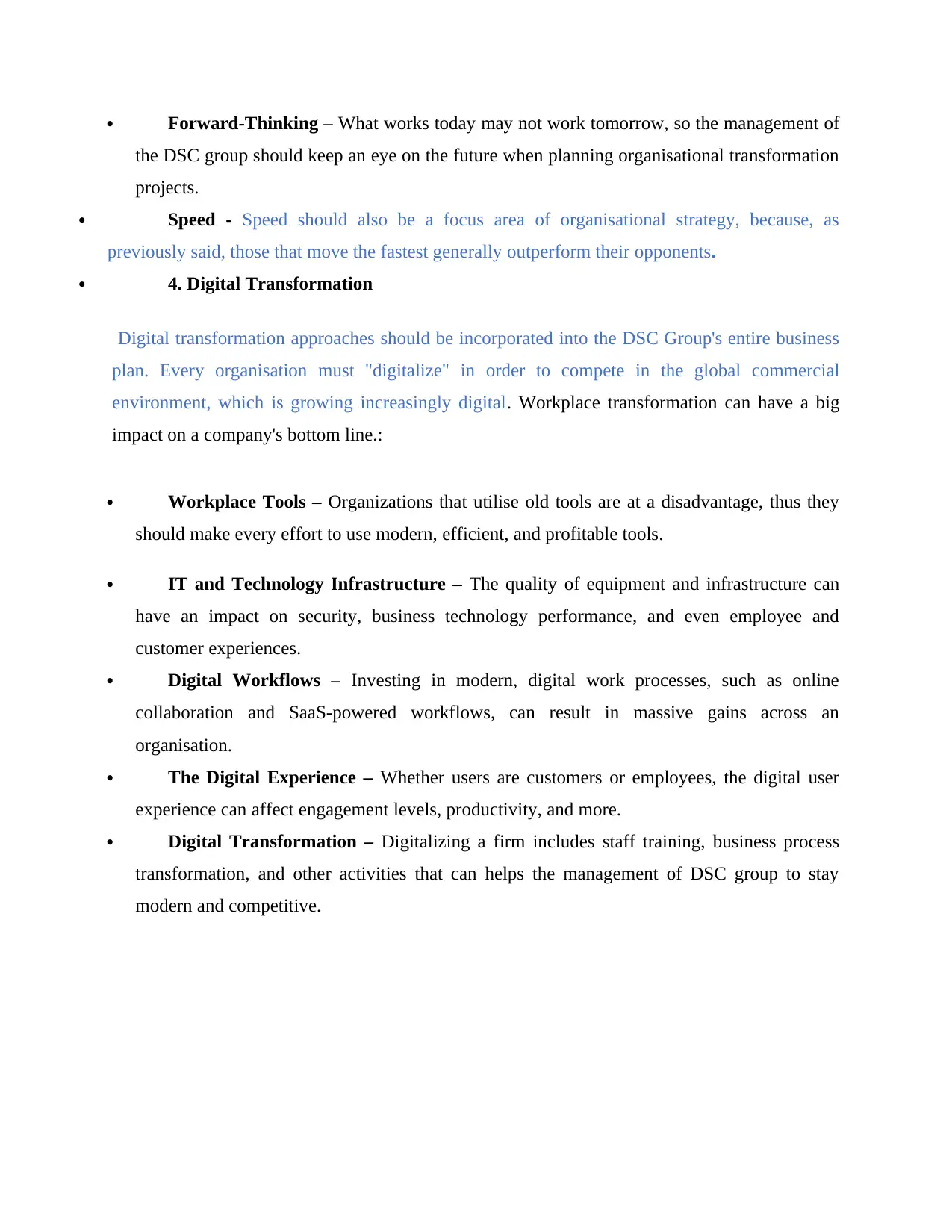
Forward-Thinking – What works today may not work tomorrow, so the management of
the DSC group should keep an eye on the future when planning organisational transformation
projects.
Speed - Speed should also be a focus area of organisational strategy, because, as
previously said, those that move the fastest generally outperform their opponents.
4. Digital Transformation
Digital transformation approaches should be incorporated into the DSC Group's entire business
plan. Every organisation must "digitalize" in order to compete in the global commercial
environment, which is growing increasingly digital. Workplace transformation can have a big
impact on a company's bottom line.:
Workplace Tools – Organizations that utilise old tools are at a disadvantage, thus they
should make every effort to use modern, efficient, and profitable tools.
IT and Technology Infrastructure – The quality of equipment and infrastructure can
have an impact on security, business technology performance, and even employee and
customer experiences.
Digital Workflows – Investing in modern, digital work processes, such as online
collaboration and SaaS-powered workflows, can result in massive gains across an
organisation.
The Digital Experience – Whether users are customers or employees, the digital user
experience can affect engagement levels, productivity, and more.
Digital Transformation – Digitalizing a firm includes staff training, business process
transformation, and other activities that can helps the management of DSC group to stay
modern and competitive.
the DSC group should keep an eye on the future when planning organisational transformation
projects.
Speed - Speed should also be a focus area of organisational strategy, because, as
previously said, those that move the fastest generally outperform their opponents.
4. Digital Transformation
Digital transformation approaches should be incorporated into the DSC Group's entire business
plan. Every organisation must "digitalize" in order to compete in the global commercial
environment, which is growing increasingly digital. Workplace transformation can have a big
impact on a company's bottom line.:
Workplace Tools – Organizations that utilise old tools are at a disadvantage, thus they
should make every effort to use modern, efficient, and profitable tools.
IT and Technology Infrastructure – The quality of equipment and infrastructure can
have an impact on security, business technology performance, and even employee and
customer experiences.
Digital Workflows – Investing in modern, digital work processes, such as online
collaboration and SaaS-powered workflows, can result in massive gains across an
organisation.
The Digital Experience – Whether users are customers or employees, the digital user
experience can affect engagement levels, productivity, and more.
Digital Transformation – Digitalizing a firm includes staff training, business process
transformation, and other activities that can helps the management of DSC group to stay
modern and competitive.
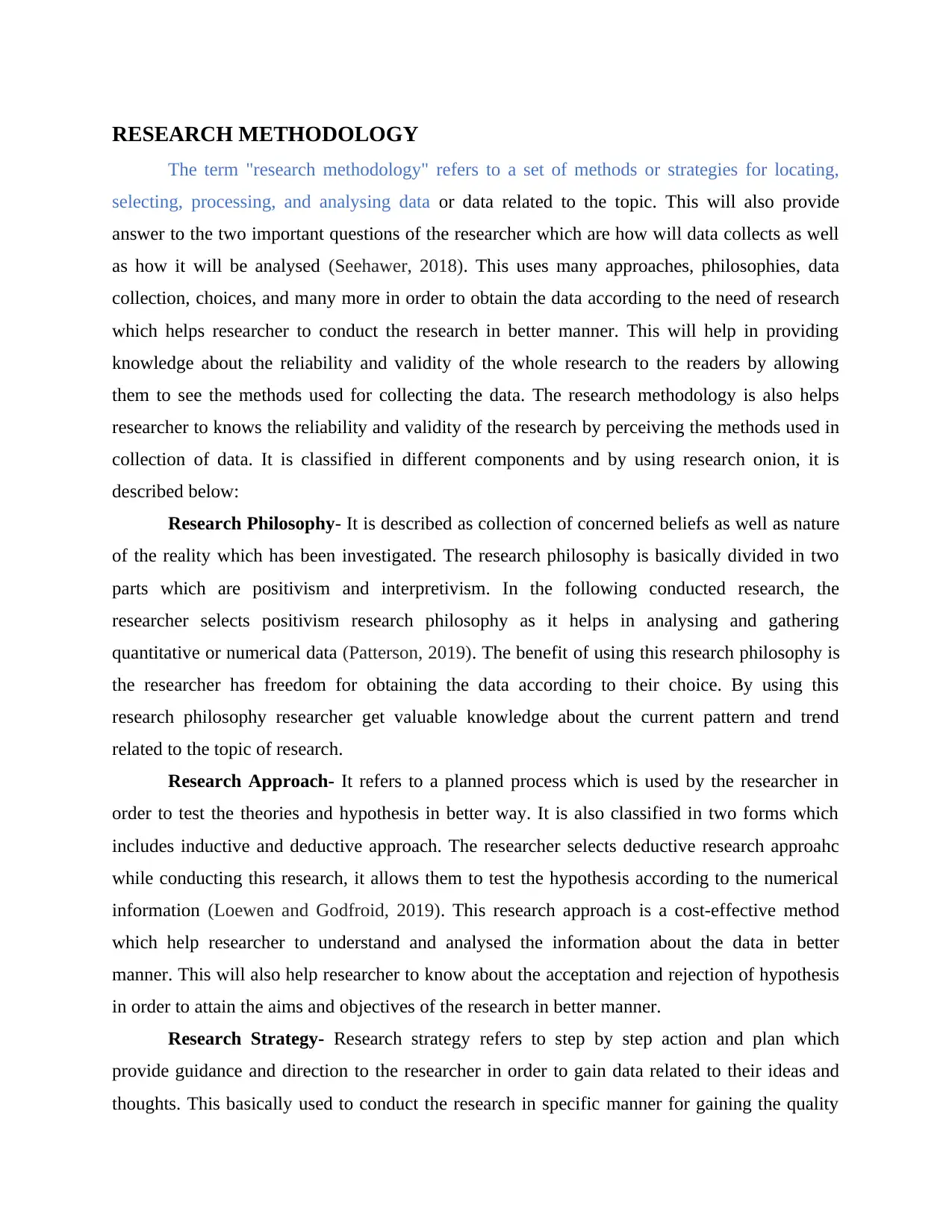
RESEARCH METHODOLOGY
The term "research methodology" refers to a set of methods or strategies for locating,
selecting, processing, and analysing data or data related to the topic. This will also provide
answer to the two important questions of the researcher which are how will data collects as well
as how it will be analysed (Seehawer, 2018). This uses many approaches, philosophies, data
collection, choices, and many more in order to obtain the data according to the need of research
which helps researcher to conduct the research in better manner. This will help in providing
knowledge about the reliability and validity of the whole research to the readers by allowing
them to see the methods used for collecting the data. The research methodology is also helps
researcher to knows the reliability and validity of the research by perceiving the methods used in
collection of data. It is classified in different components and by using research onion, it is
described below:
Research Philosophy- It is described as collection of concerned beliefs as well as nature
of the reality which has been investigated. The research philosophy is basically divided in two
parts which are positivism and interpretivism. In the following conducted research, the
researcher selects positivism research philosophy as it helps in analysing and gathering
quantitative or numerical data (Patterson, 2019). The benefit of using this research philosophy is
the researcher has freedom for obtaining the data according to their choice. By using this
research philosophy researcher get valuable knowledge about the current pattern and trend
related to the topic of research.
Research Approach- It refers to a planned process which is used by the researcher in
order to test the theories and hypothesis in better way. It is also classified in two forms which
includes inductive and deductive approach. The researcher selects deductive research approahc
while conducting this research, it allows them to test the hypothesis according to the numerical
information (Loewen and Godfroid, 2019). This research approach is a cost-effective method
which help researcher to understand and analysed the information about the data in better
manner. This will also help researcher to know about the acceptation and rejection of hypothesis
in order to attain the aims and objectives of the research in better manner.
Research Strategy- Research strategy refers to step by step action and plan which
provide guidance and direction to the researcher in order to gain data related to their ideas and
thoughts. This basically used to conduct the research in specific manner for gaining the quality
The term "research methodology" refers to a set of methods or strategies for locating,
selecting, processing, and analysing data or data related to the topic. This will also provide
answer to the two important questions of the researcher which are how will data collects as well
as how it will be analysed (Seehawer, 2018). This uses many approaches, philosophies, data
collection, choices, and many more in order to obtain the data according to the need of research
which helps researcher to conduct the research in better manner. This will help in providing
knowledge about the reliability and validity of the whole research to the readers by allowing
them to see the methods used for collecting the data. The research methodology is also helps
researcher to knows the reliability and validity of the research by perceiving the methods used in
collection of data. It is classified in different components and by using research onion, it is
described below:
Research Philosophy- It is described as collection of concerned beliefs as well as nature
of the reality which has been investigated. The research philosophy is basically divided in two
parts which are positivism and interpretivism. In the following conducted research, the
researcher selects positivism research philosophy as it helps in analysing and gathering
quantitative or numerical data (Patterson, 2019). The benefit of using this research philosophy is
the researcher has freedom for obtaining the data according to their choice. By using this
research philosophy researcher get valuable knowledge about the current pattern and trend
related to the topic of research.
Research Approach- It refers to a planned process which is used by the researcher in
order to test the theories and hypothesis in better way. It is also classified in two forms which
includes inductive and deductive approach. The researcher selects deductive research approahc
while conducting this research, it allows them to test the hypothesis according to the numerical
information (Loewen and Godfroid, 2019). This research approach is a cost-effective method
which help researcher to understand and analysed the information about the data in better
manner. This will also help researcher to know about the acceptation and rejection of hypothesis
in order to attain the aims and objectives of the research in better manner.
Research Strategy- Research strategy refers to step by step action and plan which
provide guidance and direction to the researcher in order to gain data related to their ideas and
thoughts. This basically used to conduct the research in specific manner for gaining the quality
⊘ This is a preview!⊘
Do you want full access?
Subscribe today to unlock all pages.

Trusted by 1+ million students worldwide
1 out of 30